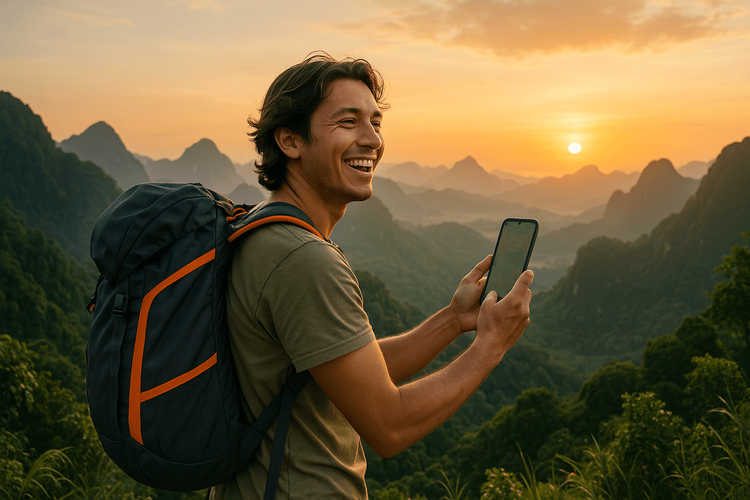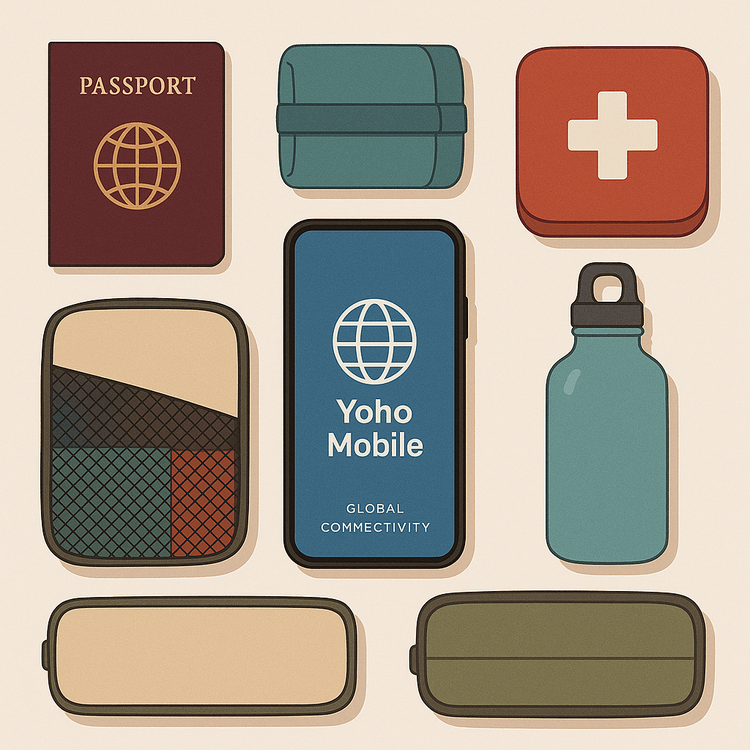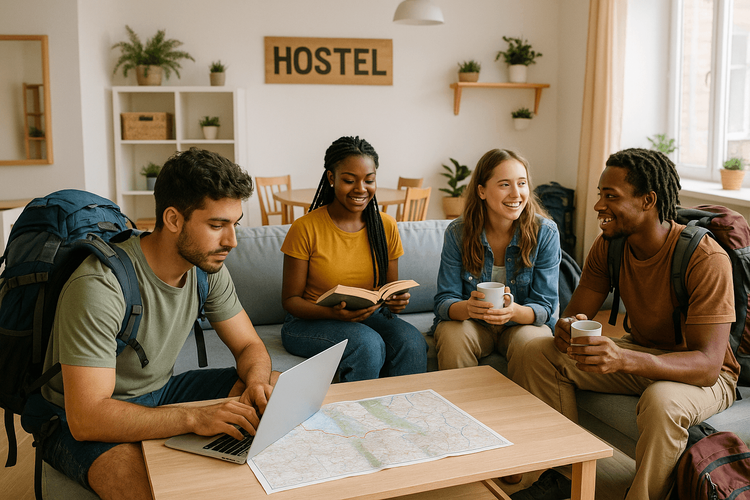Embarking on your first backpacking trip is a rite of passage. It’s the ultimate blend of freedom, adventure, and self-discovery. But let’s be honest—planning it can feel overwhelming. Where do you go? What do you pack? How do you stay safe and connected?
Fear not, aspiring globetrotter. This comprehensive solo travel guide, crafted from years of on-the-road experience, will walk you through everything you need to know. From planning your route to mastering hostel life, we’ve got you covered. And most importantly, we’ll show you how to stay seamlessly connected without the stress of roaming charges, ensuring your adventure is smooth from start to finish. Ready to begin? First, let’s make sure you have the best tool for modern travel. Explore Yoho Mobile’s eSIM plans and start your journey connected.

Phase 1: Planning Your Epic Adventure
The foundation of a great backpacking trip is solid planning. While spontaneity is part of the fun, having a framework will save you time, money, and headaches.
How to Plan a Backpacking Route
First-time backpackers often find regions with well-trodden paths the easiest to navigate. Think Southeast Asia (Thailand, Vietnam, Cambodia) or Western Europe (Spain, Portugal, Italy). These areas offer excellent infrastructure, from transportation to hostels.
- Pick an Anchor: Choose one or two must-see destinations.
- Connect the Dots: Research logical travel paths between your anchors using buses, trains, or budget airlines.
- Stay Flexible: Your plan is a guide, not a rulebook. The best moments often happen when you deviate from the itinerary. For more travel inspiration, check out renowned travel resources like the Nomadic Matt blog.
Setting Your Budget and Duration
Your budget dictates your trip’s length and style. A common benchmark for budget travel in Southeast Asia is $30-$50 per day, while Europe might be closer to $60-$80. This should cover accommodation, food, activities, and local transport. Remember to factor in pre-trip costs like flights, travel insurance, and essential gear. A longer trip doesn’t always mean a more expensive one, as you can take advantage of slower travel and monthly accommodation discounts.
Essential Documents Checklist
- Passport: Must be valid for at least six months beyond your planned return date.
- Visas: Check the requirements for every country you plan to visit. Some countries offer visas on arrival, while others require applications in advance.
- Travel Insurance: Non-negotiable. It protects you from medical emergencies, trip cancellations, and theft.
- Digital Copies: Keep photos of all your important documents saved in the cloud and on your phone.
Phase 2: Packing Like a Pro
The golden rule of backpacking is to pack light. Every extra pound is one you’ll have to carry on your back. Here’s a breakdown of what to pack for your first backpacking trip.
The Ultimate Backpacking Essentials Checklist
- The Right Backpack: A 40-50 liter backpack is perfect for most trips.
- Packing Cubes: Life-changing for organization.
- Clothing: 3-5 quick-dry t-shirts/tops, 1 long-sleeve shirt, 1 pair of versatile pants/trousers, 1 pair of shorts/skirt, 1 lightweight waterproof jacket, enough underwear and socks for a week.
- Footwear: One pair of comfortable walking shoes and one pair of flip-flops/sandals.
- Toiletries: Travel-sized everything. Solid toiletries (shampoo bars, etc.) save space and prevent spills.
- First-Aid Kit: Band-aids, antiseptic wipes, pain relievers, and any personal medications.
- Tech Gear: Smartphone, portable power bank, universal travel adapter, and headphones.

Don’t Forget Connectivity
Your smartphone is your map, translator, booking agent, and lifeline. Instead of fumbling with expensive roaming or hunting for local SIM cards upon arrival, a modern solution like an eSIM (embedded SIM) is a game-changer. It allows you to download a data plan directly to your phone. Before you go, check if your device is on the eSIM compatible list.
Phase 3: Accommodation & Socializing
Where you sleep is a huge part of the backpacking experience. It’s not just a bed; it’s where you’ll meet fellow travelers and make lifelong friends.
The World of Hostels: Tips and Etiquette
Hostels are the social heart of backpacking. They’re affordable and designed for interaction. When choosing one, look at reviews on sites like Hostelworld for cleanliness, location, and atmosphere.
Basic Hostel Etiquette:
- Be quiet and use a flashlight if you’re coming in late or leaving early.
- Keep your belongings tidy and contained in your locker.
- Clean up after yourself in the kitchen and common areas.
- Be open and friendly! A simple “hello” can lead to a great conversation.

Phase 4: Staying Safe and Savvy
Backpacking is generally safe, but it’s crucial to be a smart and aware traveler, especially when exploring solo.
Tips for Staying Safe While Solo Backpacking
- Be Aware: Always be conscious of your surroundings, especially in crowded places and at night.
- Secure Valuables: Use hostel lockers and consider a money belt for your passport and cash.
- Share Your Itinerary: Leave a copy of your travel plans with someone at home and check in regularly.
- Trust Your Gut: If a situation or person feels off, remove yourself from it.
- Stay Informed: Check official travel advisories, like those from the U.S. Department of State, for up-to-date safety information on your destination.
Your Connectivity Lifeline: Why an eSIM is a Backpacker’s Best Friend
Nothing kills the vibe of arriving in a new country like the immediate stress of finding Wi-Fi or buying a local SIM card. This is where an eSIM from Yoho Mobile transforms your travel experience.
Forget exorbitant international roaming charges from your home carrier. With an eSIM, you get affordable, local rates without swapping physical cards. Here’s why it’s the perfect travel companion:
- Instant Connectivity: Activate your plan right from your phone. For iOS users, it’s incredibly simple: after purchase, just tap ‘Install’ to begin the system setup—no QR codes needed, and you’re online in under a minute. Android users can get connected quickly by scanning a QR code.
- Unmatched Flexibility: Yoho Mobile offers flexible plans you can tailor to your trip. Heading on a whirlwind tour of Southeast Asia? Build a custom eSIM plan that covers you everywhere you go. You only pay for the data, countries, and duration you need.
- The Yoho Care Safety Net: Worried about running out of data while navigating a new city? With Yoho Care, you’re never completely cut off. It provides a backup data connection to help you find Wi-Fi or top up your plan, ensuring you’re never truly stranded.
- Try Before You Go: Still on the fence? Get a free trial eSIM from Yoho Mobile and test the service before you even pack your bags. It’s a risk-free way to experience the convenience.
Frequently Asked Questions (FAQ)
How much money do I need for my first backpacking trip?
This varies wildly by destination. For a budget-friendly trip in Southeast Asia, aim for $30-50 per day. In Europe or Australia, $60-80+ is more realistic. Always have an emergency fund of at least $500.
Is it safe to travel solo for the first time?
Yes, millions of people travel solo safely every year. The key is to be prepared, stay aware of your surroundings, research your destinations, and trust your intuition. Staying connected with a reliable data plan also adds a huge layer of security.
What’s the single most important item to pack for backpacking?
Besides your passport, a good pair of broken-in, comfortable walking shoes is arguably the most critical item. You’ll be on your feet constantly, and blisters can ruin your trip. An open mind comes in a close second!
How does an eSIM work for international travel?
An eSIM is a digital SIM that lets you activate a cellular plan without a physical SIM card. For travel, you can buy a data plan for your destination country (e.g., a Thailand eSIM plan) before you leave, activate it upon arrival, and instantly connect to the local network for data access.
Your Adventure Awaits
Your first backpacking trip is more than just a vacation; it’s an investment in yourself. You’ll learn to be resourceful, independent, and open to the world in ways you never imagined. By planning ahead, packing smart, and ensuring you have a reliable way to stay connected, you’re setting yourself up for the adventure of a lifetime.
So go ahead, book that flight and take the leap. The world is waiting. Start your journey with confidence. Check out Yoho Mobile’s flexible eSIM plans and stay connected from the moment you land!
